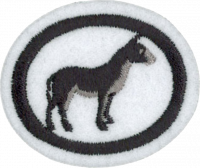Difference between revisions of "AY Honors/Livestock/Answer Key/es"
(Created page with "Especialidades JA/Animales domésticos/Respuestas") |
(Created page with "</noinclude> {{:Adventist Youth Honors Answer Book/Percheron/es}}") |
||
| Line 3: | Line 3: | ||
<section begin="Body" /> | <section begin="Body" /> | ||
{{ansreq|page={{#titleparts:{{PAGENAME}}|2|1}}|num=1}} | {{ansreq|page={{#titleparts:{{PAGENAME}}|2|1}}|num=1}} | ||
| − | <noinclude> | + | <noinclude></noinclude> |
| − | </noinclude> | + | <!-- 1. Distinguir entre el caballo de tiro (fuerte y pesado) y el caballo ligero. --> |
| − | <!-- 1. | ||
| − | |||
| − | |||
| − | + | {{clear}} | |
| − | |||
| − | |||
| − | + | <noinclude></noinclude> | |
| − | <noinclude | ||
| − | |||
{{CloseReq}} <!-- 1 --> | {{CloseReq}} <!-- 1 --> | ||
{{ansreq|page={{#titleparts:{{PAGENAME}}|2|1}}|num=2}} | {{ansreq|page={{#titleparts:{{PAGENAME}}|2|1}}|num=2}} | ||
| Line 24: | Line 17: | ||
</div></noinclude> | </div></noinclude> | ||
{{ansreq|page={{#titleparts:{{PAGENAME}}|2|1}}|num=2a}} | {{ansreq|page={{#titleparts:{{PAGENAME}}|2|1}}|num=2a}} | ||
| − | <noinclude> | + | <noinclude></noinclude> |
| − | </noinclude> | + | {{:Adventist Youth Honors Answer Book/Percheron/es}} |
| − | {{:Adventist Youth Honors Answer Book/Percheron}} | ||
| − | |||
| − | + | <noinclude></noinclude> | |
| − | <noinclude | ||
| − | |||
{{CloseReq}} <!-- 2a --> | {{CloseReq}} <!-- 2a --> | ||
{{ansreq|page={{#titleparts:{{PAGENAME}}|2|1}}|num=2b}} <!--T:5--> | {{ansreq|page={{#titleparts:{{PAGENAME}}|2|1}}|num=2b}} <!--T:5--> | ||
| − | <noinclude> | + | <noinclude></noinclude> |
| − | </noinclude> | + | {{:Adventist Youth Honors Answer Book/Belgian/es}} |
| − | {{:Adventist Youth Honors Answer Book/Belgian}} | + | <noinclude></noinclude> |
| − | <noinclude | ||
| − | |||
{{CloseReq}} <!-- 2b --> | {{CloseReq}} <!-- 2b --> | ||
{{ansreq|page={{#titleparts:{{PAGENAME}}|2|1}}|num=2c}} | {{ansreq|page={{#titleparts:{{PAGENAME}}|2|1}}|num=2c}} | ||
| − | <noinclude> | + | <noinclude></noinclude> |
| − | </noinclude> | + | {{:Adventist Youth Honors Answer Book/Clydesdale/es}} |
| − | {{:Adventist Youth Honors Answer Book/Clydesdale}} | + | <noinclude></noinclude> |
| − | <noinclude | ||
| − | |||
{{CloseReq}} <!-- 2c --> | {{CloseReq}} <!-- 2c --> | ||
{{ansreq|page={{#titleparts:{{PAGENAME}}|2|1}}|num=2d}} | {{ansreq|page={{#titleparts:{{PAGENAME}}|2|1}}|num=2d}} | ||
| − | <noinclude> | + | <noinclude></noinclude> |
| − | </noinclude> | + | {{:Adventist Youth Honors Answer Book/Arabian/es}} |
| − | {{:Adventist Youth Honors Answer Book/Arabian}} | + | <noinclude></noinclude> |
| − | <noinclude | ||
| − | |||
{{CloseReq}} <!-- 2d --> | {{CloseReq}} <!-- 2d --> | ||
{{ansreq|page={{#titleparts:{{PAGENAME}}|2|1}}|num=2e}} | {{ansreq|page={{#titleparts:{{PAGENAME}}|2|1}}|num=2e}} | ||
| − | <noinclude> | + | <noinclude></noinclude> |
| − | </noinclude> | + | {{:Adventist Youth Honors Answer Book/Shetland/es}} |
| − | {{:Adventist Youth Honors Answer Book/Shetland}} | ||
| − | |||
| − | + | <noinclude></noinclude> | |
| − | <noinclude | ||
| − | |||
{{CloseReq}} <!-- 2e --> | {{CloseReq}} <!-- 2e --> | ||
{{CloseReq}} <!-- 2 --> | {{CloseReq}} <!-- 2 --> | ||
| Line 78: | Line 57: | ||
</div> | </div> | ||
| − | + | <noinclude></noinclude> | |
| − | <noinclude | ||
| − | |||
{{CloseReq}} <!-- 3 --> | {{CloseReq}} <!-- 3 --> | ||
{{ansreq|page={{#titleparts:{{PAGENAME}}|2|1}}|num=4}} | {{ansreq|page={{#titleparts:{{PAGENAME}}|2|1}}|num=4}} | ||
| Line 91: | Line 68: | ||
</div> | </div> | ||
| − | + | <noinclude></noinclude> | |
| − | <noinclude | ||
| − | |||
{{CloseReq}} <!-- 4 --> | {{CloseReq}} <!-- 4 --> | ||
{{ansreq|page={{#titleparts:{{PAGENAME}}|2|1}}|num=5}} | {{ansreq|page={{#titleparts:{{PAGENAME}}|2|1}}|num=5}} | ||
Revision as of 18:26, 15 April 2021
Nivel de destreza
2
Año
1945
Version
19.05.2024
Autoridad de aprobación
Asociación General
1
2
2a
2b
2c
2d
2e
3
- Mules are almost always sterile. They are a cross between a male donkey and a female horse. The sterility is attributed to the different number of chromosomes the two species have: donkeys have 62 chromosomes, while horses have 64. Their offspring thus have 63 chromosomes which cannot evenly divide.
- Mules are generally considered to be more intelligent than either horses or donkeys.
- Its short thick head, long ears, thin limbs, small narrow hooves, short mane, absence of chestnuts (horny growths) inside the hocks, and tail hairless at the root, make the mule look like a donkey.
- Its height and body, shape of neck and croup, uniformity of coat, and teeth, make it look like a horse.
- The mule possesses the sobriety, patience, endurance and sure-footedness of the donkey, and the vigour, strength and courage of the horse.
- Their hooves are harder than horses, and they show a natural resistance to disease and insects.
- They are capable of striking out with any of their hooves in any direction.
4
The Spanish brought donkeys, called "burros" in Spanish, to North America, where they were prized for their hardiness in arid country and became the beast of burden of choice by early prospectors in the Southwest United States. In the western United States the word "burro" is often used interchangeably with the word "donkey" by English speakers. Sometimes the distinction is made with smaller donkeys, descended from Mexican stock, called "burros," while those descended from stock imported directly from Europe are called "donkeys."
5
6
- Jersey
- Brown Bessie, the famous champion butter cow of the Chicago World's Fair dairy test, averaged over 40 pounds (18 kg) of milk a day for five months, and made 3 pounds (1.3 kg) of butter a day several times.
- Guernsey
- Guernsey cows produce around 6000 liters per cow per year, or 16.4 liters (4.3 gallons) per day.
- Holstein
- Recorded cows in the USA produced 22,347 pounds (10,158 kg) of milk at 3.64% fat and 3.05% protein.
7
The word milch is German for milk, so one might correctly infer that the milch goat is one that has been bred for milk production. An angora goat is bred for wool production. Adventist Youth Honors Answer Book/Goat Breeds/Saanen
8



